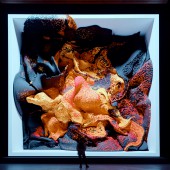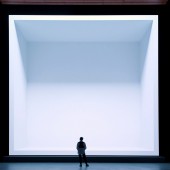Nature Dreams Digital Art Exhibition by Refik Anadol Studio |
Home > Winners > #137691 |
 |
|
||||
| DESIGN DETAILS | |||||
| DESIGN NAME: Nature Dreams PRIMARY FUNCTION: Digital Art Exhibition INSPIRATION: Machine Hallucinations is an ongoing exploration of data aesthetics based on collective visual memories of nature. Since the inception of the project during his 2016 during Google AI Residency, Anadol has been utilizing machine intelligence as a collaborator to human consciousness, specifically DCGAN, PGAN and StyleGAN algorithms trained on these vast datasets to reveal unrecognized layers of our external realities. UNIQUE PROPERTIES / PROJECT DESCRIPTION: The most visited art installation in Germany in 2021, Nature Dreams is a giant LED screen displaying machine generated, dynamic pigments that propose a novel aesthetic approach to a vast photographic dataset of nature. An architectural exhibition of synesthetic reality experiments based on GAN algorithms developed by AI, Nature Dreams turns this dataset into latent multisensory experiences to commemorate the beauty of the earth we share. OPERATION / FLOW / INTERACTION: Simulating nonlinearity of time and experiences in immersive environments comes with the interdisciplinary question of how new media art and post-digital architecture can help artists speculate new definitions of consciousness and intelligence. From this perspective, cognitive neuroscientist Anil Seth’s research on consciousness and hallucination poses inspirational challenges to define the scope of such immersive art projects. Seth proposes that normal perception can be seen as a kind of “controlled hallucination,” and the brain uses predictions and models “to best anticipate the flow of noisy and ambiguous sensory signals in which it is continually immersed.” What Machine Hallucinations series seeks to uncover is the possibility of creating a similar immersion experience through art to feel like we are in the mind of a machine that hallucinates based on the nature data that it artificially “perceives.” PROJECT DURATION AND LOCATION: The research for the project started in the summer of 2021 at Refik Anadol Studio. The exhibition of the final work took place in Berlin between November 6 and December 17, 2021. |
PRODUCTION / REALIZATION TECHNOLOGY: GAN AI algorithms, LED Screen SPECIFICATIONS / TECHNICAL PROPERTIES: 10M x 11.5M TAGS: Data sculpture, Immersive Art, Digital Art, Architecture and Design, AI-based Art, Generative Algorithms, Nature, Data Analysis RESEARCH ABSTRACT: Imagining nature as a visually attainable totality lies at the heart of the artwork. In this work, Anadol and his team apply machine learning to millions of nature images that they take as their raw data set, and train a generative model to create a latent multi-sensory experience. The artwork unveils a significant aspect of the relationship among memories, nature, and digital art by incorporating pigments, shapes, and patterns that we associate with our various experiences with nature while paying homage to its unbound poetic sublimity. Machine Hallucinations is an ongoing project of data aesthetics based on collective visual memories of space, nature, and urban environments. Since the inception of the project in 2016 (Google AI Residency), our studio has been utilizing machine intelligence as a collaborator to human consciousness, specifically DCGAN, PGAN and StyleGAN algorithms trained on these vast datasets to unfold unrecognized layers of our external realities. We collect data from digital archives and publicly available resources and process them with machine learning classification models such as CNN’s, Variational Autoencoders and deep ranking, to filter out people, noise and irrelevant data points. The sorted image datasets are then clustered into thematic categories to better understand the semantic context of the data universe. This expanding data universe not only represents the interpolation of data as synthesis, but also becomes a latent cosmos in which hallucinative potential is the main currency of artistic creativity. In order to capture these hallucinations from a multi-dimensional space, we use Nvidia’s StyleGAN, StyleGAN2 and StyleGAN2 Ada which generates a model for the machine to process the archive and the model is trained on subsets of the sorted images, creating embeddings in 1024 dimensions. As a masterfully curated multi-channel experience, Machine Hallucinations brings a self-regenerating element of surprise to the audience and offers a new form of sensational autonomy via cybernetic serendipity. CHALLENGE: We wanted to create a nature-themed project, because we thought that we, not only artists but the entire humanity, needed to focus more on our role in protecting nature. It's probably the most important topic of any future-oriented conversation. Nature is also one of the most inspiring themes for an artist who sees data as pigment. And during the pandemic, we started to focus on how we could represent nature in diverse ways by using AI. How can we reconstruct it in virtual space? To what extent can AI be a tool of reconstructing a sense of nature and draw attention to the dangers of losing it? Here, we want to emphasize that we have no intention to replace nature with simulation or suggest this as a future possibility for experiencing nature, but we are speculating representation models in the Metaverse. We challenge this virtual physical space and the sense of constant displacement that it discloses. We collected 200 million nature photos over the last two years. They were taken at various locations, but the dataset included images from pretty much every single national park in the world. Rainforests like Amazons, landscapes, remarkable spaces, clouds, trees, flora systems, water, ocean - we have an extremely diverse nature dataset and its still growing as part of this ongoing research project. ADDED DATE: 2022-02-27 19:23:48 TEAM MEMBERS (14) : Refik Anadol (Director) , Alex Morozov, Carrie He, Christian Burke, Daniel Seungmin Lee, Efsun Erkilic, Kerim Karaoglu, Pelin Kivrak, Ho Man Leung, Nidhi Parsana, Raman K. Mustafa, Rishabh Chakrabarty, Toby Heinemann and Yufan Xie IMAGE CREDITS: Refik Anadol Studio PATENTS/COPYRIGHTS: Refik Anadol Studio |
||||
| Visit the following page to learn more: https://www.koeniggalerie.com/exhibition |
|||||
| AWARD DETAILS | |
 |
Nature Dreams Digital Art Exhibition by Refik Anadol Studio is Winner in Generative, Algorithmic, Parametric and AI-Assisted Design Category, 2021 - 2022.· Press Members: Login or Register to request an exclusive interview with Refik Anadol Studio. · Click here to register inorder to view the profile and other works by Refik Anadol Studio. |
| SOCIAL |
| + Add to Likes / Favorites | Send to My Email | Comment | Testimonials | View Press-Release | Press Kit | Translations |







